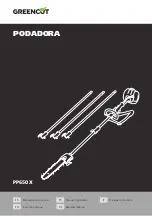
Air Nibbler
7
Visit www.princessauto.com for more information
8036216
V 2.8
AIR COMPRESSOR
Ensure the compressor used with the air nibbler can supply the required Cubic Feet per Minute at the required
PSI (see Specifications).
1. Use proper size and type of air pressure line and fittings
2. Use only clean, dry, regulated compressed air at the
rated range as marked on the tool.
CAUTION! Do not use an air source besides an air compressor
to power this tool.
3. Always use an air regulator, an in-line filter and a
moisture trap in your compressed air system. These
accessories will increase the tool’s life and keeps the
tool in good working condition. See the diagram for
recommended components of an airline.
4. Avoid using an air hose that is too long. The longer
the hose, the lower the pressure that reaches the tool,
possibly causing it to cease functioning. As well, a longer
hose can become a tripping hazard.
5. Air Tool CFM consumption ratings are based upon a 25%
duty cycle. If you require continuous duty, a larger compressor may be required. See Specifications for the
tool’s continuous duty limit.
AIR SOURCE INSTALLATION
WARNING! Never use pure oxygen, carbon dioxide, combustible gases or any bottled gas as an air source for a
tool. Such gases are capable of causing an explosion and serious injury to persons.
1. Set the air pressure regulator on the air compressor to 90 PSI. Do not exceed the air impact wrench’s
recommended air pressure. Excess pressure could result in damage to the tool or serious personal injury.
2. Prepare a standard 1/4 in. air connector for use with your tool. Wrap the threaded portion of the air
connector with thread seal tape. Wrap in a clockwise direction so it will not unravel when attaching to a quick
connector. Attach it to the air nibbler’s air inlet and tighten.
3. Attach a standard quick connector to the air source’s hose. Attach the air hose to the tool’s air connector.
4. Check the air line and its connections for air leaks. Do not use the air nibbler until you have repaired
all air leaks.








































